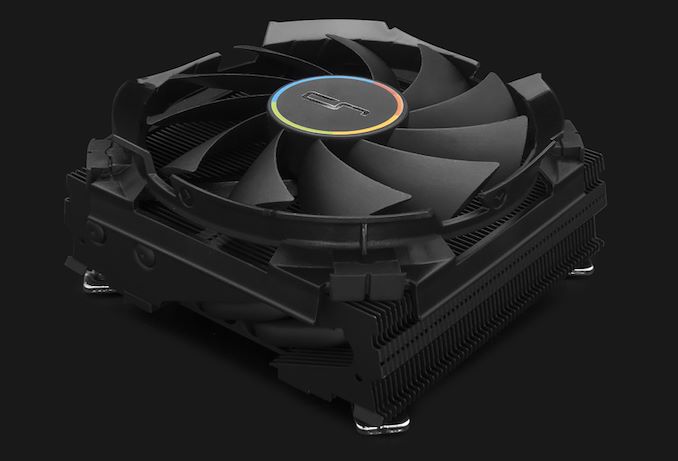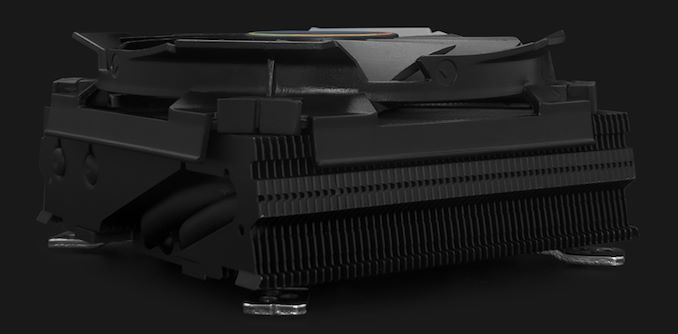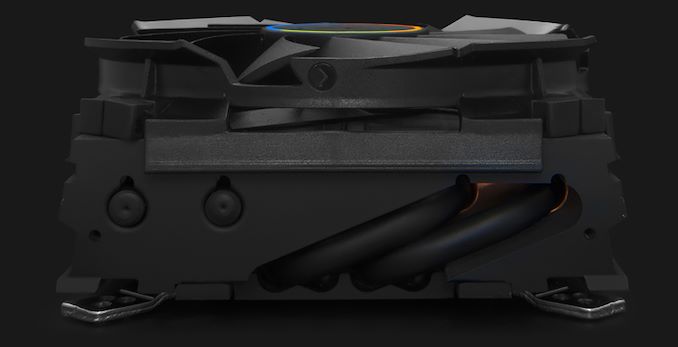Cryorig C7 G Is A 47mm Low-Profile Cooler with a Graphene Coating, Rated for 125W
by Anton Shilov on September 26, 2019 3:00 PM EST- Posted in
- Cooler
- AMD
- Intel
- Cases/Cooling/PSUs
- cryorig

Cryorig has introduced its low-profile CPU cooling system for small form-factor PCs that can dissipate up to 125 W. Featuring a 47-mm z-height and a 97-mm depth/width, the Cryorig C7 G is among the smallest coolers for higher-end processors available today. To make C7 G's high performance possible, Cryorig had to apply graphene coating on the heatsink.
As owners of SFF PCs demand higher-performance components, cooling designers are creating low-profile coolers rated for TDP levels of 95 W of higher. To maximize efficiency of such devices, manufacturers use copper for heatsinks, many heat pipes, and large fans. Cryorig decided to go one step further and applied graphene coating to the radiator’s fins. Thermal conductivity of graphene is in the range of 3000 - 5000 W/mK at room temperature (according to Graphene-Info), which is considerably higher than thermal conductivity of aluminum (250 W/mK at 25ºC) or copper (401 W/mK at 25ºC), so applying it on the fins could theoretically improve cooling performance.
Just like regular Cryorig’s C7, the model C7 G features four 6-mm heat pipes and a 97-mm PWM fan with 11 curved blades that rotates at a speed of 600 – 2500 RPM producing airflow of up to 40.5 CFM as well as rated for a maximum load noise level of 30 dB(A).
As far as compatibility is concerned, the Cryorig C7 G cooling system can work with all modern platforms from AMD and Intel, including the latest AM4 and LGA1155 sockets.
| The Cryorig C7 G Specifications | ||||
| C7-G | ||||
| CPU TDP | 125 W | |||
| Material | Copper base, graphene covered fins | |||
| Dimension with Fan | 97 mm (W) × 47 mm (H) × 97 mm (D) | |||
| Heat Pipes | 4 × 6 mm heat pipes | |||
| Air Pressure | ~ 1.36 mm H2O | |||
| Air Flow (CFM) | 40.5 CFM | |||
| Speed | 600 ~ 2500 RPM | |||
| Noise | up to 30.2 dBA | |||
| Type of Bearing | ? | |||
| Life Expectancy | ? | |||
| Weight | 673.5 grams | |||
| Compatibility | AMD | AM4/FM2+/FM2/FM1/AM3+/AM3/AM2+/AM2 | ||
| Intel | LGA1151/1150/1155/1156 | |||
Cryorig’s C7 G cooler will be available in Japan starting September 28 for ¥9,960 without sales tax ($92.50), which is certainly higher than average for an air cooler. Evidently, graphene coating is expensive and dissipating up to 125 W using a cooling system featuring a 47 mm z-height is a unique capability, so the price can be justified. The unit is already listed on the company’s website, so its launch in other countries is imminent.
Related Reading:
- ID Cooling IS-50X Low-Profile SFF Cooler, Rated for 130 W TDP
- ID Cooling Unveils IS-30 Low-Profile 30-mm Cooler for 100 Watt CPUs
- SilverStone Launches 33mm Nitrogon NT08-115XP CPU Cooler for Ultra-Thin PCs
- 3-Way Low Profile CPU Cooling Shoot-Out: Reeven, Phanteks, & Noctua
Source: Cryorig (via Hermitage Akihabara)












57 Comments
View All Comments
peevee - Tuesday, October 1, 2019 - link
Nope. The transfer of heat to air does not happen by radiation, it happens by direct transfer (or convection).Technically very very little is transferred by radiation to water vapor in the air and very very very very very very little to a few molecules of CO2 in air would also happen if the air would be about -100C (as CO2 absorption line is at 15 micrometers, so CO2 misses almost all radiation at normal room temperatures, just a tiny narrow line well off the BBR peak). But both of those are absolutely insignificant compared to convective transfer, and the air radiates the heat right back.
Santoval - Friday, September 27, 2019 - link
You seem to recall black body radiation. A body with a deep black color is better at absorbing heat (beside visible light) when it is cooler than its environment. Conversely, when the environment is cooler than the black body object, the heat flow reverses : the object gets better at radiating heat to its environment. It also helps when that object, or at least its surface, has a very high thermal conductivity, because that should enhance the heat absorption/radiation.That radiator does not have a very deep black color though. It seems to reflect at least 5% of the visible light that hits it. The closest you get to an ideal black body (at least for visible light, near and mid infrared) the more you amplify the heat radiation/absorption. A team of researchers coated a large natural diamond with a "forest" of vertical nanotubes that literally turned it into a black void, making it absorb 99.96% (or 99.995%, the article mentions both numbers) of all light that hits its surface, from every angle.
Vertical nanotubes form *much* deeper black bodies than graphene because they trap light and heat among them kind of like light is trapped by trees of a very dense forest, though nanotubes are far denser. On the contrary, graphene's layers are horizontal, not vertical, so light is largely trapped among the graphene layers which is much less efficient.
Even on my poor contrast TN monitor that "black diamond" looked like it opened a hole in it. Someone with an IPS or OLED screen will surely view this magnificent black in all its glory :
The article : https://phys.org/news/2019-09-blackest-black-mater...
And the diamond picture (before and after) directly :
https://scx2.b-cdn.net/gfx/news/hires/2019/2-miten...
katsetus - Friday, September 27, 2019 - link
If this was actually graphene, i.e. single layer graphite, it would not look black, as a single layer graphene is invisible to the naked eye.The HB pencil joke earlier is probably a good idea of what the coating is - a carbon paste (perhaps containing graphene or more realistically graphite) on the surface.
ShieTar - Friday, September 27, 2019 - link
Or the protective black paint you have to apply on top of the graphene, because a unprotected graphene layer would probably not survive for very long ...PeachNCream - Friday, September 27, 2019 - link
Or a protective coating to cover up the delusional fantasy designed to land more sales to suckers at a higher price than said suckers were willing to pay previously.katsetus - Friday, September 27, 2019 - link
Yeah. What is the point of adding something with potentially better thermal conductivity than copper into a coating that will not have better thermal conductivity than copper.I thought the graphene meme had died, but it has found a new niche.
Santoval - Friday, September 27, 2019 - link
It is probably still undefined -at least in the commercial sector, surely researchers have defined it (or not?)- where graphene ends and where graphite starts. A "few layers" of graphene is still considered graphene, but where exactly does it start being graphite? 10 layers? 20 layers? 40 layers? More? Do the graphene layers need to be deposited on one another in a special way, perhaps with intermediate insulating layers of some other material, or not? Do they need to be aligned in a particular way or do they self-align?For as long as there are no clear answers to such questions (I mean available to the general public, not confined in academic circles), ideally some kind of standard or certification which certifies what graphene is and what is not, most "graphene" sold commercially will be crude graphite.
MASSAMKULABOX - Friday, September 27, 2019 - link
Didnt MiChael Jagger have something to say on this subject ?Smells a bit like Teen Gimmick to me .. but who knows ...
Surfacround - Monday, September 30, 2019 - link
you mean (the late great) Kurt Cobain?... (song as in “smells like teenage spirit, which was (as rumour/wikipedia goes) the perfume of the drummer of “bikini kill” )... i digress.abufrejoval - Friday, September 27, 2019 - link
wonder if pencil dust makes it a dust at-tractor beam